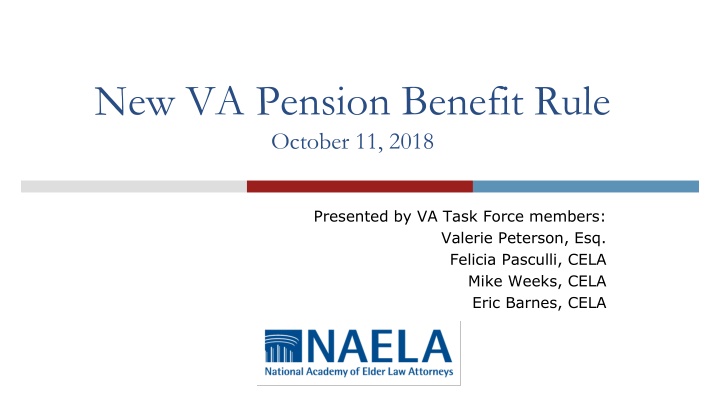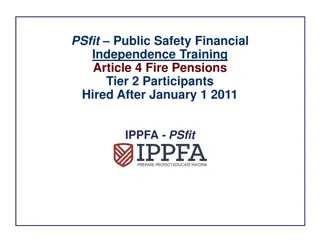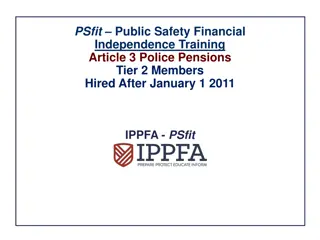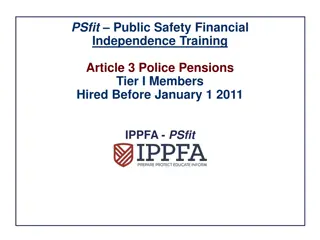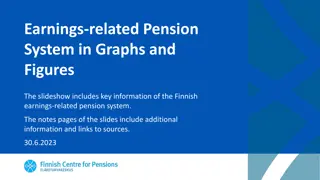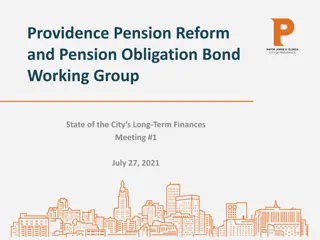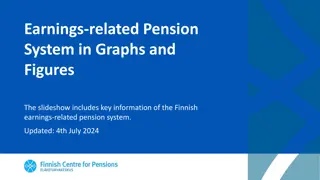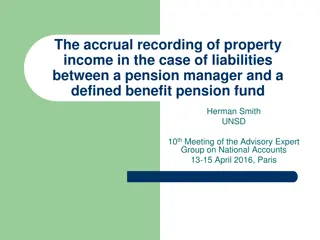The New VA Pension Benefit Rule of October 11, 2018
VA Task Force members presented key changes in the VA pension benefit rule, focusing on net worth limits, transfer rules, exclusions, look-back periods, and penalties. The rule aims to uphold program integrity and align with GAO recommendations, impacting eligibility criteria for applicants. Key sections cover net worth, annuities, trusts, medical expense deductions, and planning strategies under the new rule.
Download Presentation

Please find below an Image/Link to download the presentation.
The content on the website is provided AS IS for your information and personal use only. It may not be sold, licensed, or shared on other websites without obtaining consent from the author.If you encounter any issues during the download, it is possible that the publisher has removed the file from their server.
You are allowed to download the files provided on this website for personal or commercial use, subject to the condition that they are used lawfully. All files are the property of their respective owners.
The content on the website is provided AS IS for your information and personal use only. It may not be sold, licensed, or shared on other websites without obtaining consent from the author.
E N D
Presentation Transcript
New VA Pension Benefit Rule October 11, 2018 Presented by VA Task Force members: Valerie Peterson, Esq. Felicia Pasculli, CELA Mike Weeks, CELA Eric Barnes, CELA
Sections Part I: Net Worth and Transfer Rules Part II: Annuities and Trusts Part III: Deductions for Medical Expenses Part IV: Planning Under the New Rule
PART I: NET WORTH AND TRANSFER RULES Valerie Peterson, Esq.
Purpose of the New Rules To maintain the integrity of the pension program Respond to GAO recommendations
Net Worth Net worth limit is equal to the maximum CSRA amount (currently $123,600) Increases per the Social Security benefit increase percentage each year Home is still not counted as part of net worth Reasonable lot area defined as not more than two acres unless the additional acreage is not marketable
Net Worth Includes all income and assets Assets: FMV of all property owned by the claimant and any dependents, less mortgages or other encumbrances Exclusions: Home plus two acres, personal effects (rules specifically mention family transportation vehicles)
Look-Back and Penalty Period 36 month look-back period Triggered by the receipt of an original claim or a new claim following a period of non-entitlement Will not apply to transfers made prior to 10-18-18 Only covered assets that are transferred will be penalized An asset that was part of the claimant s net worth and if not transferred would have caused net worth to be over the limit
Example of Covered Assets (From the Rules) Claimant has $115,900 and annual income of $0 at the time of the VA application Gave a friend $30,000 prior to applying for VA pension If $30,000 hadn t been transferred before application, net worth would have been $145,900 and would have been excessive. Covered asset amount is $22,300 ($145,900-$123,600) and will incur a penalty
Look-Back and Penalty Period Veteran has $110,000 in total assets, $12,000 in income Total net worth = $122,000 Transferred $50,000 on Nov. 1, 2018 Applied for VA pension on Nov. 15, 2018 Approved! Because the amount transferred was not from assets over the net worth limit (covered assets), no penalty will be imposed
Look-Back and Penalty Period Penalty period based on the MAPR for aid and attendance for a married Veteran Starts the month after the transfer is made MAPR is divided by 12 to come up with the monthly amount MAPR with one dependent used for a married veteran ($2,169) Penalty period is rounded down
Example of Net Worth and Penalty Period Veteran owns one bank account with $200,000 Annual income is $24,000 UMEs total $34,000 Total net worth: $200,000 Veteran transferred $80,000 on Nov. 1, 2018 Filed for VA pension on Dec. 1, 2018 Net worth=$120,000 Penalty period - $76,400/$2169= 35.22
Net Worth and Penalty Period Penalty would start on Dec. 1, 2018 and run for 35 months (rounded down from 35.22)
Lookback and Penalty Period Only amount of assets transferred that exceed the net worth limit are subject to penalty ( covered assets ) Includes transfers to a trust or annuity (with exceptions that would cause them to be counted as an asset) Five year cap on the penalty period
Exceptions to the Transfer Penalty The result of fraud or unfair business practice Transfer to a trust established for a child incapable of self-support prior to 18 No circumstances that the Veteran, Veteran s spouse or surviving spouse can benefit Transfer was from assets that were not over the $123,600 limit
Curing a Gift Curing Gifts May be a partial or total cure Cure must be made before the claim was filed or within 60 days of the notice of penalty Evidence of the return/cure must be received not later than 90 days after the notice of decision
Advising Clients As long as transfers were made by 10-17-18, they will not be penalized, regardless of the date of application Net worth rules at the time of application will apply
Advising Clients Adding owners to accounts won t decrease the value of the asset if done after 10-18. If done before then, will be evaluated under current rules. Take a proactive planning approach with those who aren t quite ready get some assets into a properly drafted irrevocable trust now so no waiting for 36 months when they are ready
PART II: ANNUITIES AND TRUSTS Felicia Pasculli, CELA
Inclusion of Annuities and Trusts in Definition of Transfer for Less Than Fair Market Value
Under New VA Pension Regs Definition of annuities under new regs Annuities are specifically identified as an instrument the VA considers as a transfer for less than fair market value under certain circumstances 3.276 (a)(5)(ii)(a) annuity means a financial instrument that provides income over a defined period of time for an initial payment of principal.
IMMEDIATE ANNUITIES Two kinds of immediate annuities: COMMUTABLE - They can be cashed in less a penalty This kind of annuity (asset) is one where the claimant establishes that he or she has the ability to liquidate the entire balance of the asset for the claimant s own benefit. If the claimant establishes that the asset can be liquidated, the asset is included as net worth A commutable immediate annuity is not a divestment but treated as a deferred annuity. No consideration of withdrawal penalty.
NON-TRANSFERABLE OR NON- COMMUTABLE ANNUITIES Non-Transferable Immediate Annuity The voluntary purchase of such an annuity within the 3-year look-back period is subject to a transfer penalty. This applies to annuities purchased after October 18, 2018. This also applies to a deferred annuity which is annuitized after the October 18thdate. But only when the amount divested into the annuity was in excess of the $123,600 asset limit. Penalty would also apply if spouse purchases an immediate annuity.
EXCEPTION DIVESTMENT FOR MANDATORY RETIREMENT ANNUITY Annuities that are mandated upon retirement VA acknowledges that conversion of deferred retirement accounts to immediate annuities is required under some retirement plans but only in the comments to the regs. 3.276(a)(5)(ii) Actually says such an annuity will not be considered a covered asset but income will count Caveat - the rule describes annuities that are transferred voluntarily. The inference is it excepts those that are mandatory.
EXCEPTION FOR ANNUITY PURCHASES AS A RESULT OF FRAUD OR UNFAIR BUSINESS PRACTICES 3.276(c) An asset transferred as the result of fraud, misrepresentation, or unfair business practice related to the sale or marketing of financial products or services for purposes of establishing entitlement to the VA pension will not be considered a covered asset. Evidence supporting this exception may include, but is not limited to, a complaint contemporaneously filed with state, local, or federal authorities reporting the incident.
TO RECAP Depends on if you bought it in the 3-year look-back period, if it can be liquidated, and if its value keeps the net worth under the $123,600 If an annuity cannot be liquidated and it was purchased before the look-back period, then the annuity is not considered an asset; however distributions count as income and the timing of the purchase could warrant a penalty period. Annuities could present a double whammy not only does the value count but also the distribution of the income
TRUSTS 3.276 (a)(5)(ii)(B) Trust means a legal instrument by which an individual (the grantor) transfers property to an individual or an entity (the trustee), who manages the property according to the terms of the trust, whether for the grantor s own benefit or for the benefit of another individual.
Three Types of Trusts, Revocable, Irrevocable, and Supplemental Needs Trusts Establishing a trust does not always result in a penalty period. Transfers to annuities or trusts over which a claimant retains control and the ability to liquidate are transfers for fair market value and not subject to a penalty period. They can be liquidated so they are considered an asset.
ITS ALL ABOUT NEW WORTH The VA is using a very bright line of $123,600.00. They call it a CSRA, but it is not because they count household income and assets. Therefore, whether your money is in a trust or not, as long as its corpus, along with the claimant s income after UMEs are deducted is under $123,600 the claimant is eligible.
WHAT IF THE CORPUS EXCEEDS THE NET WORTH STANDARD? Revocable trust corpus gets spent down before achieving eligibility Irrevocable trust funding date is critical. If funded before October 18, 2018 and claimant has no control over the income or principal not counted. But The VA has challenged irrevocable grantor trusts over the last few years Citation nr: 1529488 board of veterans appeals decision
Grantor and non-grantor trusts in VA pension planning The distinction of a grantor vs. Non-grantor trust is significant. 1. The VA compares income report to the IRS and SSA records with their records. This is referred to as an income verification match. (IVM) 2. If a veteran establishes a trust which is taxed as a grantor trust, the income will be assumed by the VA to be the claimant s income and may preclude pension benefits. 3. Safest to structure trust as a non-grantor trust 4. Caveat problem with personal residence and retention of property tax exemptions and capital gain exclusions.
WHAT ABOUT SALE OF HOME DURING CLAIMANTS LIFETIME? The effect of a sale is to convert a non-countable asset into cash, which is considered in calculating net worth. To preserve exclusion of gain (Internal Revenue Code 121 exclusion), the trust must be a grantor trust. It is my opinion that a claimant s personal residence should be held in a grantor trust with no provision for access to income or principal. However, once sold, the proceeds should be distributed out of the trust to the trust beneficiaries or to a non-grantor trust.
POSITIVE CHANGE SNTs ALLOWED The VA will not consider as a covered asset an asset that a veteran, a veteran s spouse, or a veteran s surviving spouse transfer to a trust established on behalf of a child of the veteran if:
1. The VA rates or has rated the child incapable of self-support under 3.356 3.356 (a) A child must be shown to be permanently incapable of self-support by reason of mental or physical defect at the date of attaining the age of 18 years. 2. There is no circumstance under which distributions from the trust can be used to benefit the veteran, the veteran s spouse, or the veteran s surviving spouse.
Mike Weeks, CELA, Esq. PART III: DEDUCTIONS FOR MEDICAL EXPENSES
Why are Medical Expenses Important? Just like under old pension law, medical expenses are an offset of income (IVAP) to extent they exceed 5% of Maximum Base Pension Rate (based on household size) Both proposed and final regulation had substantial changes to what was a qualifying medical expense (deduction for IVAP) Generally, proposed law was more restrictive than before (i.e. cap on payment rate) Final regulation is typically more generous than before (300 comments submitted)
Where to find new rules Deductible medical expenses are part of 38 CFR 3.278 (b) defines terms (c) broad strokes of medical expenses care, medications, supplements, adaptive equipment, transportation expenses, Insurance premiums (d) details in-home care and facility expenses (e) exclusions from deductible expenses
ADL vs IADL Comments requested expansion of ADLs to include IADL (like medication reminders) VA declined to expand to include all IADL s, but did allow expansion in some cases. See 38 CFR 3.278(d) Added ambulating to traditional list of bathing, dressing, eating, toileting and transferring Medication administration- licensed caregiver unless satisfied conditions of 3.278(d)
Licensure of Care Givers Proposed Rule often required a care giver to be licensed for medical expense to count Final Rule clarifies a important exception to licensure requirement for custodial care Either assistance with two or more ADLS (like before) Certification by health professional that due to a physical, mental, or cognitive disorder the individual requires [the custodial care]- 3.278(d)(2) and (3)(iv)(4)
Facility-Based Care No real change for skilled nursing care (still valid expense) Other facilities get a specific section in 3.278(d)(3). This represents expansion from Fast Letter 12-23 Family members are OK to provide care (no pay requirement) Licensed caregiver required unless claimant is housebound or needs A&A and is receiving medical care or custodial care (See (d)(3)(iv))
Previously Approved Applicants Comments are clear that intent was not to cause any previously approved claimant to see a reduction in benefits Trap is if the care provider changes, then subject to re- evaulation Shouldn t be overly problematic because of ability to use certification letter
Summary Definition of medical expenses has been expanded Medical professional letters are very important Need for licensed professionals is reduced No cap on payments Lots of opportunity in independent and assisted living to have rent treated as medical expense
Eric Barnes, CELA, Esq. PART IV: PLANNING UNDER THE NEW RULE
STRATEGIES: SOME NEW, SOME OLD, AND SOME BOLD
Strategies: Pre-Planning Transfer assets in trust or outright and wait out 36 months Caregiver contracts to reduce assets over time Planning around first death of married couple Used for couples with excess resources Assets transferred to dying spouse who passes them to children in death OR Surviving spouse executes a disclaimer Uncertainty: Is the failure to exercise an elective share or execution of a disclaimer something that can be penalized?
Strategies: Crisis Planning General spend down Pay for care, services, a vacation, etc. Buy personal property "suitable to and consistent with a reasonable mode of life. See 3.275(b)(2). Buy or upgrade vehicle(s). See 3.275(b)(2). Pay off debt Buy or renovate a home
Strategies: Crisis Planning General spend down continued . . . Prepaid funeral services Uncertainty: Regs do not provide a specific exemption for this. Comment to 3.276 says VA would regard it as a fair market value purchase. Does it then become part of the assets? What if it is irrevocable and non-transferrable, does it still have value? Purchase life estate in home of another A life estate is countable to net worth (VAOPGCPREC 15-92), unless excluded under 3.275(b) as the veteran s dwelling (VAOPGCPREC 9- 95). This is useful for both VA and Medicaid planning purposes, but Medicaid requires applicant to live in life estate for one year.
Strategies: Crisis Planning Exempt transfer to trust for child disabled before 18. See 3.276(d). Child must be disabled before 18 years of age Rated as incapable of self-support under 3.356 No possible benefit to veteran, veteran's spouse, or surviving spouse Purchase and lease out primary residence Claimant can live in various other care settings and maintain exemption Can lease out the home and maintain exemption Rental income counts as IVAP. See 3.275(b)(1)(ii).
Strategies: Crisis Planning Transfer exempt assets such as home and cars to irrevocable trust Exempt assets are not part of net worth and there are not "covered assets. See 3.275(a) and 3.276(a)(2). Regs do not automatically impose a penalty for transfers to trust. May also transfer non-covered assets to start 5 year Medicaid clock Sell property on an installment contract Payments will not count as income More options to reduce income through UME s. Can pay . . . Family members Independent living facilities. See 3.278(d).
Strategies: Crisis Planning Half-a-Loaf Calculate excess/disqualifying/covered assets Calculate burn rate Take total monthly budget, including all non-care expenses Add the Monthly Penalty Rate ($2,169 for 2018) Subtract gross monthly income Calculate plan length Calculate and make gift (may also gift non-covered assets) Plan Length = Excess assets Burn Rate Gift Amount = Plan Length X Monthly Penalty Rate ($2169 for 2018)
Strategies: Crisis Planning Half-a-Loaf Example: Joe has $100,000 of excess/disqualifying/covered assets. His entire monthly budget is $4500. His gross monthly income is $2100. How much of a gift should Joe make and how long will it take for him to become eligible? Budget $4,500 Divisor +$2,169 Income -$2,000 Burn Rate $4,669 Excess Assets $100,000 Burn Rate Plan Length Divisor Plan Length Gift $2,169 X 21.42 $4,669 21.42 $46,460 Apply 6 months (or so) before end of penalty period
